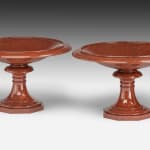Pair of Swedish Röd Rännås Porphyry Tazze
SWEDEN, EARLY 19TH CENTURY
26 x 42 cm
10 ¼ x 16 ½ in
10 ¼ x 16 ½ in
JL03
Further images
Provenance
Private Collection, USASold Sotheby's New York, 27th September 1996, lot 133
with Jeremy Ltd., London
Private Collection, Switzerland
Each with a circular dished top with a raised rim, on a ring turned, waisted spreading circular socle and raised on an octagonal base. Despite being derived from the Ancient...
Each with a circular dished top with a raised rim, on a ring turned, waisted spreading circular socle and raised on an octagonal base.
Despite being derived from the Ancient Greek word for "purple" (πoρφύρα), the name 'porphyry' has a wide range of colours, from black and grey to orangey reds and greens. In 1731 it was found in Sweden's Älvdalen (Elfdal) (until then the only source was Egypt) and Sweden emerged as a major producer of porphyry objects in the late eighteenth and early nineteenth centuries.
In order to introduce the splendour of the French Empire style to Sweden, Charles XIV, the first of the Bernadotte Kings, purchased the works once mining began in the 1780s. Numerous porphyry items in various forms were exported around Europe during this period as diplomatic gifts.
Despite being derived from the Ancient Greek word for "purple" (πoρφύρα), the name 'porphyry' has a wide range of colours, from black and grey to orangey reds and greens. In 1731 it was found in Sweden's Älvdalen (Elfdal) (until then the only source was Egypt) and Sweden emerged as a major producer of porphyry objects in the late eighteenth and early nineteenth centuries.
In order to introduce the splendour of the French Empire style to Sweden, Charles XIV, the first of the Bernadotte Kings, purchased the works once mining began in the 1780s. Numerous porphyry items in various forms were exported around Europe during this period as diplomatic gifts.
1
of
44






